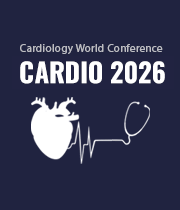Title : Metabolic and echocardiographic predictors of ventricular extrasystoles burden in non-ischemic patients
Abstract:
Background: Ventricular premature complex (VPC) is one of the most common ventricular arrhythmias and is strongly associated with heart failure (HF), all-cause hospitalization, and cardiovascular hospitalization
Patients and Methods: Fifty-eight patients with ventricular extrasystoles symptoms with no ischemic history or diagnosis, were assigned to metabolic profile included: lipogram (total cholesterol, HDL, LDL and triglycerides) serum total calcium, vitamin D, Glycated hemoglobin (HBA1c), parathyroid hormone values. 24hrs Holter monitoring assessment of ventricular extrasystolic total burden percentage. Transthoracic echocardiography parameters included (left ventricular end diastolic and systolic dimensions, EF%, diastolic function grading and LA dimensions). Correlation analyses were performed between the number of PVCs per 24 hours and the clinical, biochemical, and echocardiographic variables. Both visual inspection of scatter plots with fitted regression lines and Pearson’s correlation coefficients (r) were used to assess the strength, direction, and significance of associations. For interpretive clarity, the magnitude of correlation was categorized using conventional thresholds: strong correlation for r ≥ 0.70, moderate correlation for r = 0.40–0.69, and weak correlation for r < 0.40.
Results: There was a moderate correlation with PVCs burden, and higher prevalence in older patients (r ≈ 0.44, p < 0.05). Sex, hypertension, and diabetes mellitus were weakly correlated with PVC burden. Among biochemical parameters: Total cholesterol and LDL showed moderate positive correlations with PVC burden (r = 0.45–0.50, p < 0.05). HDL, triglycerides, Vitamin D and HbA1c did not exhibit significant linear associations (r values close to zero, p > 0.05). Serum calcium was weakly positive (r = 0.054). Serum PTH was weakly positive (r = 0.092). Left ventricular dimensions (LVEDD and LVESD) correlated moderately with PVCs (r ≈ 0.40– 0.50, p < 0.05). Diastolic dysfunction grading was positively correlated (r ≈ 0.42, p < 0.05). Ejection fraction (EF%) was only weakly correlated (r < 0.20, NS).
Conclusion: Ventricular extrasystolic burden was moderately correlated with left ventricular dimensions, diastolic dysfunction grading, older age, LDL and total cholesterol values. weakly associated with serum calcium and parathyroid hormone values and did non exhibit significant correlation with other biochemical markers included Vitamin D, triglycerides and HDL cholesterol.
Acknowledgement: Great thanks to my father, mother, wife, sons, and daughter for continuous support during these years.




